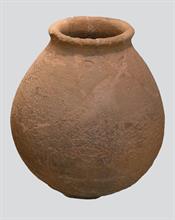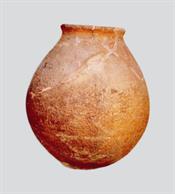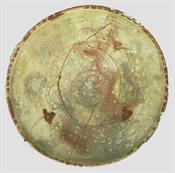COLLECTIONS / Ceramics
The Byzantine Museum's Ceramics Collection contains ca 3,100 objects dating from the Early Christian era to the Post-Byzantine period. Although the bulk of the material is made up of sherds, often of unknown provenance, there are some intact items, of everyday use for the most part. Small oenochoe (wine ladles), lekythoi (small flasks for scented oils), little jars, perfume bottles and lamps are the most common ceramic vessels of the Early Christian era which come for the most part from excavations of Early Christian tombs in the Athens area and elsewhere. The collection includes also representative samples of glazed tableware from the mid-and late Byzantine period, mainly plates or cups.
The Collection contains also Post-Byzantine vessels from main Greece and Balkans, but also imported ceramics from Italy (maiolica) or pottery made in Ottoman workshops (Iznik).
-
 Storage Jar
Clay spherical storage jar with a rounded bottom. Around the shoulder are six cross-stamps with symbolical letters . Found in...
Storage Jar
Clay spherical storage jar with a rounded bottom. Around the shoulder are six cross-stamps with symbolical letters . Found in... -
 Storage jar
Storage jar made of clay from a church at Amygdaleza, in Stamata, Attica, 6th c.
Storage jar
Storage jar made of clay from a church at Amygdaleza, in Stamata, Attica, 6th c. -
 Cup
Most likely it comes from the Byzantine shipwreck in Alonessos / North Sporades.
Cup
Most likely it comes from the Byzantine shipwreck in Alonessos / North Sporades. -
 Clay cup
Large, glazed ceramic bowl (cup) with a depiction of a bird. This decorative motif is depicted in the sgraffito technique wit...
Clay cup
Large, glazed ceramic bowl (cup) with a depiction of a bird. This decorative motif is depicted in the sgraffito technique wit... -
 Clay vessel, Chafing dish (Saltsario)
Glazed fireproof clay vessel in the shape of an inverted cone, with two handles. Used for preparing and serving sauces. At th...
Clay vessel, Chafing dish (Saltsario)
Glazed fireproof clay vessel in the shape of an inverted cone, with two handles. Used for preparing and serving sauces. At th... -
 Askodaula
Clay vessel for the transport of water and other beverage.
Askodaula
Clay vessel for the transport of water and other beverage. -
 Plate with the depiction of a feline
Ceramic plate. Glaze enhanced by copper oxide, giving it green-yellow color. Decoration engraved on interior: large medallion...
Plate with the depiction of a feline
Ceramic plate. Glaze enhanced by copper oxide, giving it green-yellow color. Decoration engraved on interior: large medallion... -
 Oenochoe
White clay oinochoe. It was found in a tomb east of the apse of an Early Christian Basilica in Laureotikos Olympos (Kalyvia A...
Oenochoe
White clay oinochoe. It was found in a tomb east of the apse of an Early Christian Basilica in Laureotikos Olympos (Kalyvia A...
Comments
Users must be registered and logged in to comment.
No comments found.